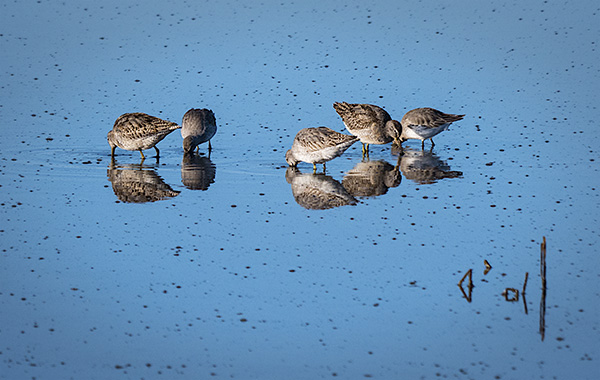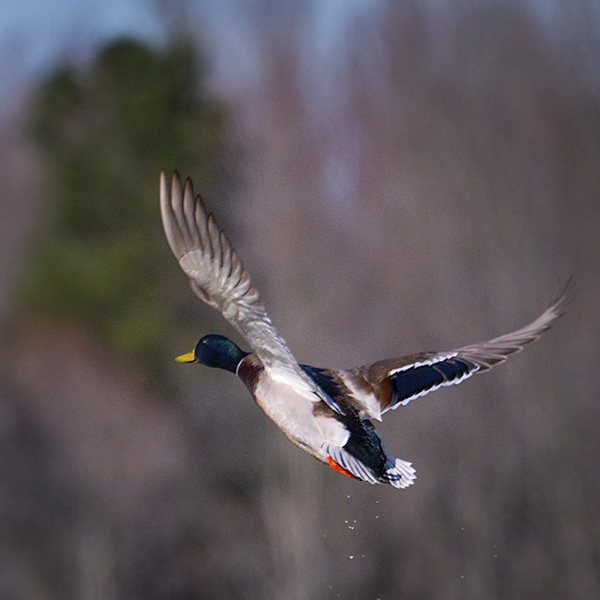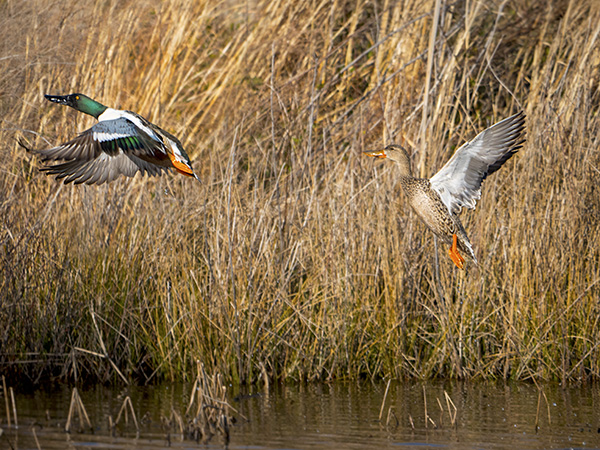
by successfulbob | bird photography, Lumix G9, photography, photography gear, travel photography, wildlife photography
Bombay Hook National Wildlife Refuge – Smyrna, Delaware
I’ve been a bit remiss in posting. Travel for speaking. Travel for family visit. And catching up upon return fronfrom the travel makes Bob a bad boy. But, I’m back and with plans to have more posts even when traveling to judge images &speak in Oregon and do a seminar and a couple workshops for the Festival of the Cranes in Socorro, New Mexico in the middle of November. We’ll see how that works out!
 Dunlin Sandpipers enjoying breakfast
Dunlin Sandpipers enjoying breakfast
While on the family visit I made it up to the Bombay Hook National Wildlife Refuge. I spent the day making images and talking photography with my friend Ned Levi. This was the first time we met in person. I highly recommend spending quality time with your peers. It’s wonderful how much you can learn from each other. (learn more about Ned and his blog)
 Thought this was an interesting formation of the Canada Geese. I normally enjoy them mor eisolatedbut the overlap of the birds is kida cool. Watcha’ think??
Thought this was an interesting formation of the Canada Geese. I normally enjoy them mor eisolatedbut the overlap of the birds is kida cool. Watcha’ think??
If you have not spent time in wildlife refuges there are some protocols that make the system work for everyone. If you do go please follow the rules and regs. use the longest lens you have and do your best to not disturb the wildlife. There’s an expression, “Take only images, leave only footprints.” Not sure I have the exact words but you understand the sentiment.
This is from the Refuge website and the rules are much the same in all refuges.
Know Before You Go
- The wildlife drive is open from 1/2 hour before sunrise to 1/2 hour after sunset daily.
- The visitor center is open weekdays from 8:00 a.m. to 4:00 p.m. year round.
- During spring and fall weekends, the visitor center is open Saturday and Sunday from 9:00 a.m. to 5:00 p.m.
- The visitor center is handicapped accessible and has educational displays and videos.
- The visitor center is closed on Federal Holidays.
- The visitor center is closed on weekends during July, August, mid-December, January, and February.
- Check the website or call to find out about refuge road closures during bad weather and hunting season. During summer months, visitor should bring insect repellent and wear long-sleeve shirts and long pants.
- To protect wildlife and their habitat and to provide the best opportunities in wildlife observation and photography, it is important not to disturb, injure, or damage plants and animals on the refuge. In fact, it is a prohibited act as stated in 50 CFR 27.51. This disturbance includes flushing birds and other wildlife or using mechanical or electronic devices to lure birds closer for observation or photography. Please remember to take only memories and photographs and leave only footprints.
- Unmanned aircraft systems (Drones) are prohibited.
 A simple houe wren was dancing in and out of the flowering bush. Behavior and movement photos are my aim.
A simple houe wren was dancing in and out of the flowering bush. Behavior and movement photos are my aim.
Images were made with the PANASONIC LUMIX G Leica DG Vario-Elmar Professional Lens, 100-400MM, F4.0-6.3 ASPH mounted on the Lumix G9.
Yours in Creative Photography, bob

by successfulbob | bird photography, flower photography, Lumix G9, photo walkabout, photography, photography gear, wildlife photography
Long Lens Photography – 100-400mm
I enjoy my long lens for outdoor photography. It’s a beautiful piece of equipment for isolating subjects against a background with nice bokeh. The longer the lens, the easier it is to have an out-of-focus background. The PANASONIC LUMIX G Leica DG Vario-Elmar Professional Lens, 100-400MM, F4.0-6.3 ASPH is a magical lens IMHO.
Here are some images from a walkabout at the Sedona Wetlands. I didn’t find many waterfowl as it was midday and possibly the wrong time of year. In any case, I always try to make the best of any photography situation and started looking for details. There are still some wildflowers scattered throughout. This attracts butterflies, birds, and bees.
 Adult female Lesser Goldfinch snacking on some wildflowers that have gone to seed
Adult female Lesser Goldfinch snacking on some wildflowers that have gone to seed
 I always look to capture ‘behavior’ photos as well as straight portraits of my feathered friends. Here the Lesser Goldfinch is working to get the seeds free from the plant.
I always look to capture ‘behavior’ photos as well as straight portraits of my feathered friends. Here the Lesser Goldfinch is working to get the seeds free from the plant.
 Butterfly caught with shallow depth of field between the plants.
Butterfly caught with shallow depth of field between the plants.
The butterfly photo was my favorite photo of the day. If you’ve chased butterflies in the wild, you know how difficult it can be to get an interesting image. I tracked this one for a while and looked to ‘sandwich’ the butterfly with DOF. I wanted a sharp subject surrounded by the in and out of focus flowers. This was made more difficult as there were not a ton of flowers in bloom and the wind was making the flowers dance as well. Now that I see the image here I’ll crop in a little tighter and loose the past prime flowers on the right-hand side of the photo.
 Wasps one of our other pollinators were flitting between the blooms as well as the butterflies.
Wasps one of our other pollinators were flitting between the blooms as well as the butterflies.
I choose this one to share as it has a different color with black and white stripes.
Back to the lens. One complaint I hear about the lens is that it is very stiff to zoom. It was designed that way not to suffer ‘lens creep’ when you hang it from your shoulder. I’ve found a perfect way to change the zoom. Instead of trying to turn the lens, hold the lens and turn the camera. It’s like opening a bottle of champagne where you hold the cork and twist the bottle. Makes it easy and you don’t end up with the lens creep!
When paired with the Lumix G9 you get 6 and a half stops of handholdability. All images were handheld in this post.
Yours in Creative Photography, Bob

by successfulbob | bird photography, Lumix G9, photography, photography creativity, photography software
Flight of the Blue Jay
I’m still a bit limited in getting out to photograph I’m trying to keep my camera reflexes in good shape. I continue looking for creative photo opportunities close to home. Anytime I can study the behavior of birds, no matter the type I find it adds to the storehouse of knowledge that will make ALL my avian photography better.
A case in point. I’ve been watching birds from my back porch and seeing what I can do to show behavior. I prefer to show movement vs. a still portrait in my work when possible. I have noticed that birds will tend to repeat patterns if they are hanging out in one area. IE a hummingbird will approach a feeder or flower a certain way almost every time returning to the same branch to rest. If a bird goes to the top of a tree, there is a good possibility that the bird will return to the same branch in a short period. I often share that you need to observe wildlife for a while before picking up your camera for the most exciting images.
 Screen capture from Adobe Bridge of bluejay flight
Screen capture from Adobe Bridge of bluejay flight
Most birds will take off into the wind. The bluejay above was facing the sun and the wind direction. The Great Blue Heron along with many other birds will usually offload some poo just before taking off. If startled or they are feeling threatened they will tend to turn away from the perceived threat.
 This bluejay landed in the top of the tree waving in the light breeze.
This bluejay landed in the top of the tree waving in the light breeze.
I watched as it left the tree and tried to memorize how it began its flight. Did it fly high and up or start to dive to create lift? How did the wings move? With that image in my mind, I set the Lumix G9 camera to SH which stands for Super High speed. It uses the electronic shutter to allow for twenty FPS. The Leica 100-400mm lens was used fully racked out to its 800MM equivalent
 Flight of the Bluejay with watercolor treatment
Flight of the Bluejay with watercolor treatment
The image above was composited using Photoshop Layers and Masks. All relevant photos were selected in Adobe Bridge. Under the Tools Menu, I chose Load Files into Photoshop Layers which placed all files into a single PSD. Additional canvas size was added to the left side. Each image was offset and masked so that each image was not overlapping. Then a series of Photoshop Filters were applied to create a watercolor feel to the image.
 Because the sky was flat, I added a cloud image to the Photoshop File.
Because the sky was flat, I added a cloud image to the Photoshop File.
A cloud image was opened and dragged into the flight file. Blend Modes were experimented with until I found one that added subtle sky detail.
This one might call for a Photoshop tutorial to show the progression of this image build. Let me know if you would like to see me produce one.
Yours in Creative Photography, Bob

by successfulbob | bird photography, fine art photography, Lumix G9, LumixGH5, photography, photography gear, wildlife photography
Blackwater National Wildlife Refuge – Part Three
If you have followed my work for any length of time, you know that I enjoy moving my work into a more painting-based look. I have taken a term I heard from Julianne Kost and adopted it for my new business. “Lens Based Artist.” I have decided to start promoting my more art based images and have begun gallery representation and selling my work as art.
More on that in future posts. (things are starting to take off. YAY!)
Back to Blackwater images and the post-processing. Here are a few photos of which I have played using the PhotoSynthesis process I have been working on over the years.
 Geese in Flight. Love the wing positions and pattern of the birds in the sky.
Geese in Flight. Love the wing positions and pattern of the birds in the sky.
I worked on this image on the plane while en route back to Arizona from my speaking engagement in Maryland where the images were captured. My seatmate was fascinated by the process, and I talked him through my thinking as I worked on the photo. There are several layers of multiple images blended using Adobe Photoshop’s blend Modes and masks. The geese in flight created their art with all the different wing positions. I was able to capture their flight using the **Lumix GH5 and the Leica 100-400mm lens. The reach of this lens with the stabilization in the camera are making captures such as this easier than ever.
 Great Blue Heron on the shoreline.
Great Blue Heron on the shoreline.
After working on the piece and adding layers of textures, I pulled the image into Skylum’s Focus CK (part of the Creative Kit or available as a stand-alone) to add a bit of selective sharpness to the subject and vignette and slight blurring to the rest of the image. I use this tool in the Macro setting quite often. I could do the same thing directly in Photoshop, but it would take much more time and many more steps to accomplish the same thing. Plugins are very handy. I decide whether to purchase plugins based on how often I perform specific techniques. When I find the plugin saves me the time or makes it possible for me to do something I would not be able to accomplish otherwise, I buy.
 Heron in Flight – All images are © Bob Coates Photography – All Rights Reserved
Heron in Flight – All images are © Bob Coates Photography – All Rights Reserved
I don’t think any of these images are ‘ready for prime time’ as yet. I think of them as sketches testing ideas and pointing to the direction I wish to go.
Yours in Creative Photography, Bob
** I’ll be using the Lumix G9 in the future for most of my wildlife shooting. Designed with the stills photographer in mind, it adds 6 1/2 stops of handholdabilty (GH5 has 5) along with a better grip and button design for still photographers.

by successfulbob | bird photography, LumixGH5, photography, wildlife photography
Blackwater National Wildlife Refuge – Part Two
While in Maryland presenting some photography programs to MDPPA I found some extra time to go in search of wildlife. I had the pleasure of spending a couple of days with Chris Paulis as he took us to the wildlife refuge from Columbia a couple of hours away in Cambridge, Maryland.
You can check the first post where I shared some large avian creatures AKA the Great Blue Herons. Today I am going to show the world of ducks that we were able to find. There were lots of Northern Shovelers which show quite beautiful plumage. If you don’t know better, it’s relatively easy to mistake their feather patterns for Mallards. Since both were hanging around you can check out the similarities and the differences.
Onward to the duck photos!
 These guys tended to stay right on the edge of being able to get beautiful photos. Male Northern Shoveler.
These guys tended to stay right on the edge of being able to get beautiful photos. Male Northern Shoveler.
Both Chris and I were using Panasonic Lumix cameras, He had the Lumix G9, and I had the Lumix GH5. We both used the Lumix G Leica 100-400mm f4.5-6.3 lens. Having that reach at full extension (800mm 35mm FF equivalent) made it possible for us to capture many of the shots that would otherwise have been more humdrum. The five-axis image stabilization enabled hand holding even fully extended. It makes a huge difference in the tracking the ever-changing movement of our subjects.
 The reflection of the sunset light on the water warms this photo of a male Mallard.
The reflection of the sunset light on the water warms this photo of a male Mallard.
 Male Mallard duck in flight.
Male Mallard duck in flight.
If at all possible I try to capture images that include behavior. Taken just after leaving the water droplets fall helping to add more detail to the story.
 This photo is one of my favorite images from the day. A couple of Northern Shoveler ducks take to the air.
This photo is one of my favorite images from the day. A couple of Northern Shoveler ducks take to the air.
It was a great day, so I probably have one or two more posts to share from our refuge adventure.
Yours in Creative Photography, Bob

 Dunlin Sandpipers enjoying breakfast
Dunlin Sandpipers enjoying breakfast Thought this was an interesting formation of the Canada Geese. I normally enjoy them mor eisolatedbut the overlap of the birds is kida cool. Watcha’ think??
Thought this was an interesting formation of the Canada Geese. I normally enjoy them mor eisolatedbut the overlap of the birds is kida cool. Watcha’ think?? A simple houe wren was dancing in and out of the flowering bush. Behavior and movement photos are my aim.
A simple houe wren was dancing in and out of the flowering bush. Behavior and movement photos are my aim.






















